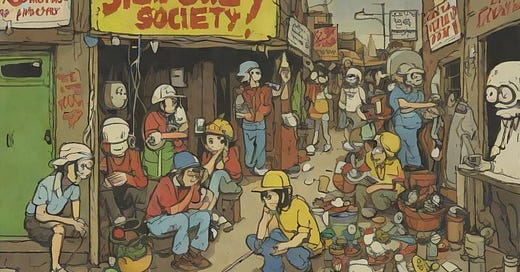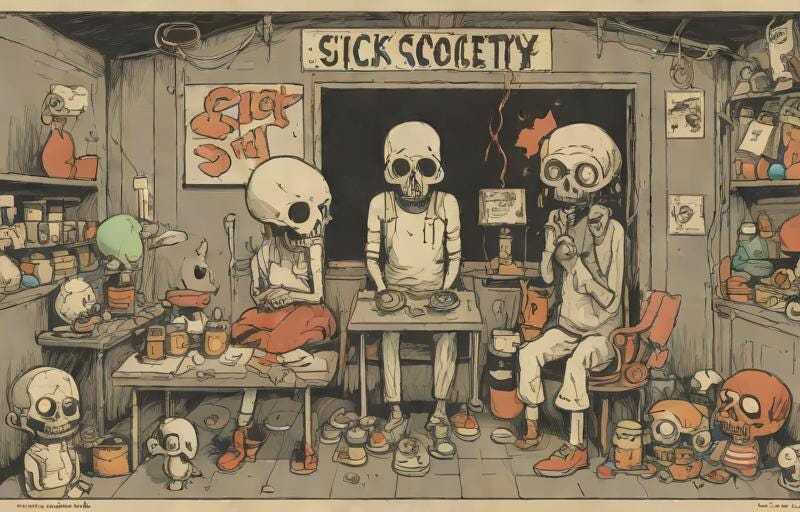Why Mental-Health Disability Is Fast becoming The New Normal
Eroding The Line Between Health And Illness
Our society has become genuinely sick. Not because it is afflicted by a dangerous virus. Nor because it suffers from the lethal consequences of a terrible natural disaster. Commentators often draw attention to the social and cultural sickness that comes in the wake of the unravelling of moral norms. At one time or another the pornification of western society, the weakening of family bonds or the reluctance to give birth to a new generation of human being have all been diagnosed as symptoms of a malaise that borders on a species of cultural illness. These are all very social and cultural afflictions, but they are not what I am thinking about when I claim that society has become genuinely sick.
What concerns me is not the kind of sickness that is a metaphor signifying a social ill but the kind of sickness that is real and turns citizens into patients.
In many western societies sickness has become normalised, and millions of people conduct their lives through the identity of being sick. Last week it was announced that there are a million more people with mental health disabilities in Britain than three years ago. Poor mental health has become the leading cause of disability among working- age adults. Two-thirds of incapacity benefit claims are based on the claim of poor mental health. The rise in the number of people who claim that they are not able to work because of a mental health disability means that the UK’s economic inactivity rate is higher than the Office of National Statistic expected. There are a record 2.7 million people off work with long-term illness, and the cost of sickness benefits for those of working age is projected to rise from £41 billion a year to £69 billion before the end of the decade.
Britain is facing a veritable epidemic of disability amongst its adult population. A survey of more than 50,000 people for the Department for Work and Pensions found that a quarter of people in Britain say they have a disability, defined as a long-term health problem which causes ‘substantial difficulty with day-to-day activities’. That the consciousness of feeling disabled is on the rise is highlighted by the fact that it has increased from a decade ago from 16 per-cent of adults to 23 per cent today. And it is principally the growth of mental illness that is responsible for the growth of adult disability.
Concern about the growing toll of ill-health on economic life has finally led a few members of the Government to raise questions about its deleterious consequences of the culture of medicalisation on society. Mel Stride, the work and pensions secretary, stated that Britain was ‘labelling the normal ups and downs of human life as medical conditions’ and that openness about mental health has ‘gone too far’. Stride had simply acknowledged the obvious problem of medicalising the problem of everyday life. In a world where Therapy Culture dominates the discourse on health and illness, the pension secretary’s common-sense warning about the danger of medicalisation provoked criticism from the mental health industry and its allies. The Labour Party’s Liz Kendall, the shadow work and pensions secretary, accused Stride of ‘ignorance’. One critic condemned ‘Mel Stride’s attack on people suffering mental health difficulties’ as ‘disgraceful’. Defenders of Therapy Culture consciously represent criticism of the medicalisation of society as an attack on sick people. What they overlook is that people feel and in many cases are ill because prevailing cultural norms incite them to feel sick.
It is evident that Britain’s political and cultural establishment is not prepared to face up to the corrosive impact of Therapy Culture on their society. It is worth noting that the scale of the problem is rarely acknowledged. For example, the problem long term mental disability among adults runs in parallel with the diseasing of childhood. The rise of mental illness among young people is even more alarming than the growth of disability amongst grown-ups. The term mental health emergency is frequently used to describe this situation.
In July last year, a report by the former children’s commissioner Anne Longfield concluded, that the mental health emergency among children is so profound that it threatens the country’s future prosperity. The report noted that one in six children aged six to 16 was identified as having a probable mental health condition, up from one in nine in 2017. There was a 47 per cent rise in the number of new emergency referrals to crisis care teams in minors between December 2019 and April 2021. In England, where over a million children in were referred to mental health specialists last year. The number of such referrals had doubled between 2017 and 2022.
In the United States almost 42 percent of Generation Z suffers from a mental illness. Less than half of them state that their mental health is OK and a staggering 40 per cent of them claim that they have seen a therapist to receive treatment.
What these figures indicate is that mental illness has become normalised and that a significant section of young people have been socialised to perceive themselves as sick.
The normalisation of mental disability is a direct consequence of the imperative of medicalisation
Health has become a dominant issue, both in our personal lives and in public life. With every year that passes, we seem to spend more and more time and resources thinking about health and sickness. More resources devoted to improving mental health appear to have the perverse consequence of making the situation worse.
Back in 2005, I predicted that the ascendancy of Therapy Culture will lead to a constant increase in the number of people that feel ill. I stated;
‘Here’s a prediction – Western societies are not going to overcome the crisis of healthcare; it is beyond the realms of possibility. No matter what policies government pursue, or how much money they throw at the problem, even if they increase health expenditure fourfold, the problem will not go away. As long as the normalisation of illness remains culturally affirmed, more and more of us are likely to identify ourselves as sick, and will identify ourselves as sick for a growing period of time. The solution to this problem lies not in the area of policymaking, or even medicine, but in the cultural sphere’.
My prediction was based on more than two decade of study of the phenomenon of Therapy Culture. The study noted that the dividing line between health and illness was becoming more and more blurred.
In my book Therapy Culture: Cultivating Vulnerablity In An Anxious Age I argue that in Western societies psychology has become the medium through which what were once considered to be the normal challenges of existence are given meaning. Our culture became therapeutic when psychological values displaced moral norms and clinical techniques became an instrument for the management of subjectivity.
Therapy Culture continually communicates a narrative that encourages people to see their everyday problem through the prism of an illness. That means that the
problems we encounter in everyday life are reinterpreted as medical ones. Problems that might traditionally have been defined as existential – that is, the problems of existence – have a medical label attached to them. Today, it is difficult to think of any kind of human experience that doesn’t come with a health warning or some kind of medical explanation. That is why in recent years even loneliness has been rebranded as a mental health problem. So-called experts assert that loneliness is likely to increase mortality by 26 percent. Since the pandemic, anxieties about the mental health consequences of loneliness have intensified. Back in 2018, the UK Government even appointed Tracey Crouch into the newly established post of ‘Minister for Loneliness’.
It is not only the experience of pain or distress or disappointment or engagement with adversity that is medicalised and seen as potentially traumatic and stress-inducing; even human characteristics are medicalised now. Consider shyness. It is quite normal to be shy; there are many circumstances where many of us feel shy and awkward. Yet shyness is now referred to as ‘social phobia’. And, of course, when a medical label is attached to shyness, it is only a matter of time before a pharmaceutical company comes up with a ‘shyness pill’. Pop these pills, and you too can become the life and soul of the party!
Even falling in love can be represented as a potential cause of a psychological illness. According to a press release:
‘Psychologists say that love sickness is a genuine disease and needs more awareness and diagnoses. Those little actions that are normally seen as the symptoms of the first flush of love – buying presents, waiting by the phone, or making an effort before a date – may actually be signs of a deep-rooted problem to come. Many people who suffer from love sickness cannot cope with the intensity of love and have been destabilised by falling in love or suffer on account of their love being unrequited….’
Of course, an intense passion can and does have an impact upon our bodies. But when even love can be seen as the harbinger of illness, what aspect of our lives can be said to be illness-free? What can we possibly do that will not apparently induce some sickness or syndrome? Medicalisation no longer knows any limits. It is so intrusive that it can impact on virtually any of our experiences, creating a situation where illness is increasingly perceived as normal.
It is amongst the young that the consequence of Therapy Culture is most devastating. Young people are socialized to embrace an outlook where the meaning of life and their of their personal identity is interpreted through the medium of psychology. The young are encouraged to become absorbed in their internal life and are provided with a psychological vocabulary with which to make sense of their emotional state. Mental-health discourse encourages young people in search of their identity to feel ill. Writing as early as the 1940s, the sociologist Robert Merton characterized this kind of development as a ‘self-fulfilling prophecy’. Tell children that they will suffer stress, trauma, and depression when they confront experiences, such as exams, and many will start to respond to those experiences in precisely those terms. The literary scholar Stewart Justman describes this as the “nocebo effect.” In contrast the placebo effect which relies on sham treatment to improve a patient’s condition, Justman ‘s nocebo effect refers to the negative health consequence of the promiscuous reliance on mental health interventions.
Spending on mental health has increased in parallel with the growth of psychological condition. That these two trends are intimately connected is rarely acknowledged by the so-called experts. Yet it is likely that the perverse outcome of mental health obsession is the creation of a public health problem.
The millions of victims of the imperative of Therapy Culture really feel sick. The nocebo effect of mental health interventions constitutes a genuine public health problem. Until society revolts against the tyranny of sickness mongering the number of victims will continue to rise. It may be too late to save those adults whose identity is defined by their mental health diagnosis. But if we challenge the prevailing model of socialization and provide children with a moral vocabulary that allows them to give meaning to their existence, we can save them from the cultural sickness afflicting their elders.






Not much of a comment other than to say because I generally quickly scan through things, focusing on the references.... I bought Therapy Culture. Have a good day.